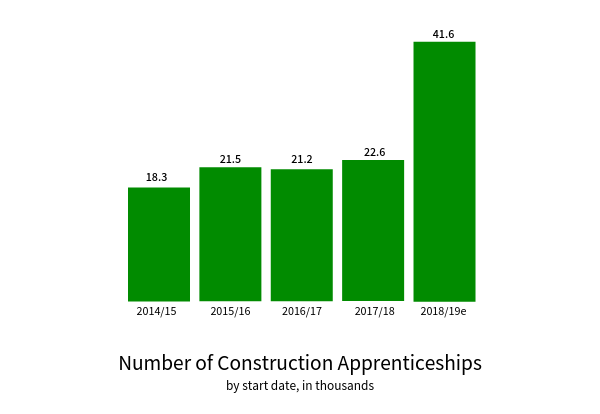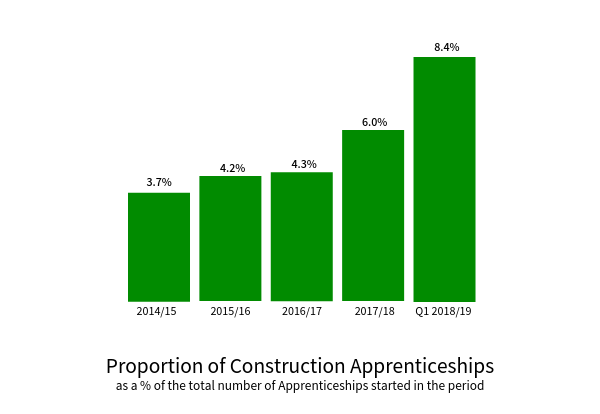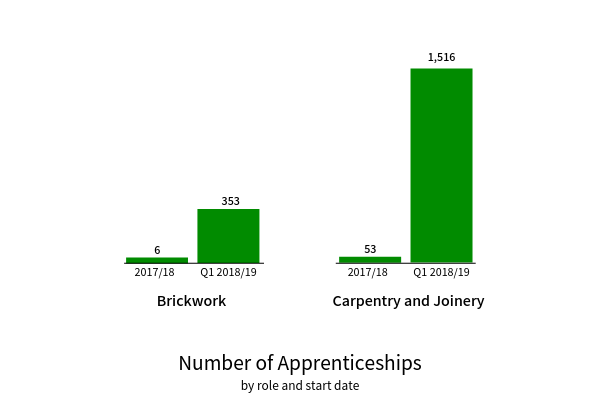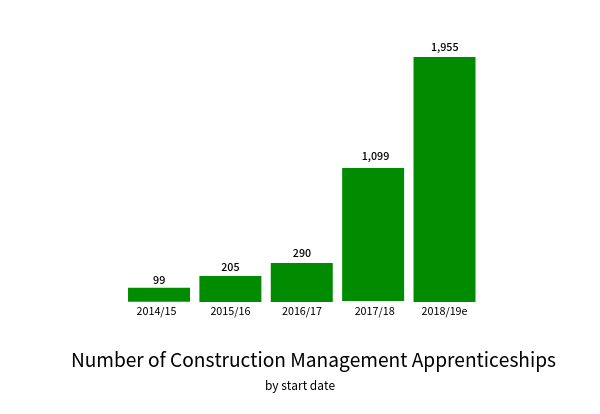Can apprenticeships solve the construction skills crisis?
With an estimated 168,500 construction jobs to be created between 2019 and 2023 according to the CITB, apprenticeships in construction have a vital role to play in helping close the construction skills gap.
Contents |
[edit] A strong uptake in construction apprenticeships
According to the apprenticeships statistics released in January 2019 by the Department for Education, the number of building and construction apprenticeships started over the past five years has significantly increased. If the current number of construction apprenticeships started in Q1 2018/19 grows at the same rate as the previous years, the number of construction apprenticeships will have doubled in a year.
Furthermore, these statistics show that the proportion of building and construction apprenticeships as part of the total number of apprenticeships has significantly increased over the period, from 3.7% in 2014/15 to 8.4% in the first three months of 2018/19.
While apprenticeships have a very important role to play in helping address the construction skills shortages, there are still some challenges ahead for certain professions.
[edit] All construction apprenticeships are not equal
[edit] Bricklaying and carpentry apprenticeships
Bricklaying is one of the skilled trades in highest demand in the UK construction industry, with an estimated shortage of 15,000 bricklayers, according to the draft Letwin report.
However, while the bricklaying apprenticeship standard was approved in June 2018, only four months after the carpentry and joinery apprenticeship standards (Level 2 and 3), there has been four times more apprenticeships started in carpentry than in bricklaying in Q1 2018/19.
This may present a risk for the ambitious government programme to build 300,000 homes annually in England.
[edit] Quantity surveying apprenticeships
The Construction and Infrastructure Survey from the Royal Institution of Chartered Surveyors (RICS) of Q1 2019 highlighted that quantity surveying is one of the construction occupations with acute staff shortages, with 60% construction companies reporting issues recruiting quantity surveyors.
It is interesting to note that, since the introduction of three surveying apprenticeships' standards (chartered surveyor degree, surveying technician and most recently geospatial survey technician), the number of apprenticeships in quantity surveying has grown steadily.
Furthermore, the majority (77%) of quantity surveying apprenticeships were started by students expecting to achieve a Chartered Surveyor degree, which is a promising outcome for the profession.
[edit]  Construction management apprenticeships
Construction management apprenticeships
The CIOB-cross industry report of January 2019 showed that two third of construction companies are struggling to hire site supervisors and site managers in the UK.
It is positive to note that the number of Construction Management apprenticeships has increased year-on-year over the past 5 years.
Furthermore, 2 apprenticeships standards in Construction Management (Construction Site Supervisor (Level 4) and Construction Site Management (Level 6)) are currently in development, which should help address the skill gap in those two professions.
[edit] Conclusion
While apprenticeships in Construction won't be able to solve the construction skill shortage challenge by themselves, the strong uptake of apprenticeships in Construction Management, Quantity Surveying and Carpentry is a positive sign for the industry.
However, more needs to be done to attract talent in certain construction trades such as bricklaying, where "flash on-the-job" training might offer a solution for the short term, as recommended by the Letwin report.
This article was created by Caroline Pegden from TempaGoGo on 16 May 2019 based on the Department for Education Apprenticeships statistics released in January 2019.
[edit] Related articles on Designing Buildings
- Apprenticeships levy.
- BSRIA call for more vocational training.
- BSRIA calls on industry to get involved with National Apprenticeship Week 2019.
- Construction apprentice earnings.
- Construction Industry Training Board CITB.
- ECA 2018 Apprentice of the Year.
- EIC apprentice support programme.
- Engineering construction skills bootcamp.
- Government Skills and Curriculum Unit GSCU.
- National vocational qualification.
- New apprentice levy funding model.
- Protection for apprenticeships.
- Skills.
- Tackling the construction skills shortage.
Featured articles and news
A change to adoptive architecture
Effects of global weather warming on architectural detailing, material choice and human interaction.
How big is the problem and what can we do to mitigate the effects?
Overheating guidance and tools for building designers
A number of cool guides to help with the heat.
The UK's Modern Industrial Strategy: A 10 year plan
Previous consultation criticism, current key elements and general support with some persisting reservations.
Building Safety Regulator reforms
New roles, new staff and a new fast track service pave the way for a single construction regulator.
Architectural Technologist CPDs and Communications
CIAT CPD… and how you can do it!
Cooling centres and cool spaces
Managing extreme heat in cities by directing the public to places for heat stress relief and water sources.
Winter gardens: A brief history and warm variations
Extending the season with glass in different forms and terms.
Restoring Great Yarmouth's Winter Gardens
Transforming one of the least sustainable constructions imaginable.
Construction Skills Mission Board launch sector drive
Newly formed government and industry collaboration set strategy for recruiting an additional 100,000 construction workers a year.
New Architects Code comes into effect in September 2025
ARB Architects Code of Conduct and Practice available with ongoing consultation regarding guidance.
Welsh Skills Body (Medr) launches ambitious plan
The new skills body brings together funding and regulation of tertiary education and research for the devolved nation.
Paul Gandy FCIOB announced as next CIOB President
Former Tilbury Douglas CEO takes helm.
UK Infrastructure: A 10 Year Strategy. In brief with reactions
With the National Infrastructure and Service Transformation Authority (NISTA).
Ebenezer Howard: inventor of the garden city. Book review.
Airtightness Topic Guide BSRIA TG 27/2025
Explaining the basics of airtightness, what it is, why it's important, when it's required and how it's carried out.

























